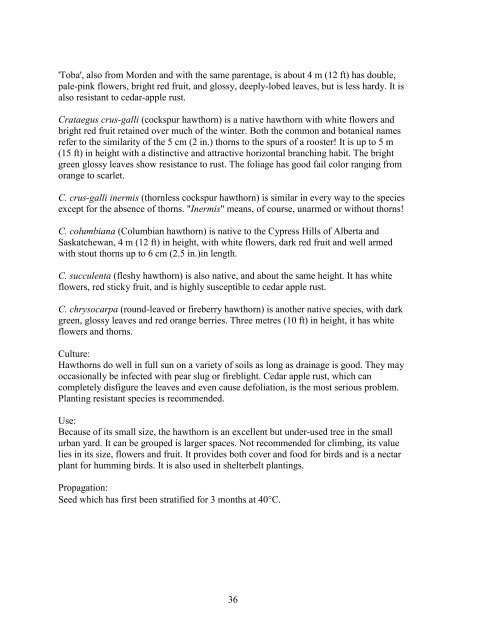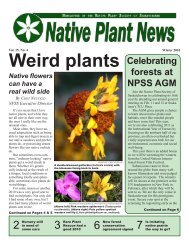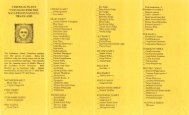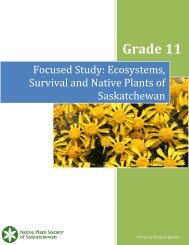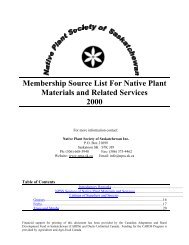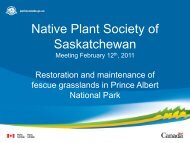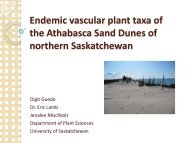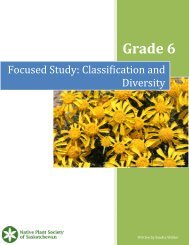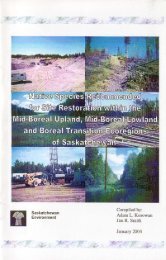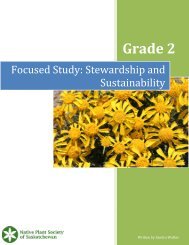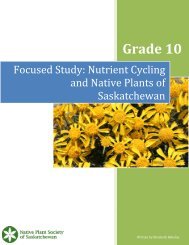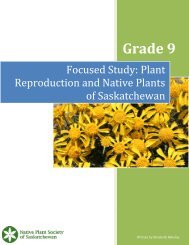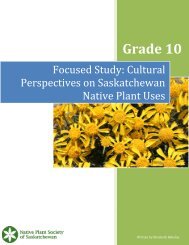Native Plants As Habitat For Wildlife - Native Plant Society of ...
Native Plants As Habitat For Wildlife - Native Plant Society of ...
Native Plants As Habitat For Wildlife - Native Plant Society of ...
You also want an ePaper? Increase the reach of your titles
YUMPU automatically turns print PDFs into web optimized ePapers that Google loves.
'Toba', also from Morden and with the same parentage, is about 4 m (12 ft) has double,<br />
pale-pink flowers, bright red fruit, and glossy, deeply-lobed leaves, but is less hardy. It is<br />
also resistant to cedar-apple rust.<br />
Crataegus crus-galli (cockspur hawthorn) is a native hawthorn with white flowers and<br />
bright red fruit retained over much <strong>of</strong> the winter. Both the common and botanical names<br />
refer to the similarity <strong>of</strong> the 5 cm (2 in.) thorns to the spurs <strong>of</strong> a rooster! It is up to 5 m<br />
(15 ft) in height with a distinctive and attractive horizontal branching habit. The bright<br />
green glossy leaves show resistance to rust. The foliage has good fail color ranging from<br />
orange to scarlet.<br />
C. crus-galli inermis (thornless cockspur hawthorn) is similar in every way to the species<br />
except for the absence <strong>of</strong> thorns. "Inermis" means, <strong>of</strong> course, unarmed or without thorns!<br />
C. columbiana (Columbian hawthorn) is native to the Cypress Hills <strong>of</strong> Alberta and<br />
Saskatchewan, 4 m (12 ft) in height, with white flowers, dark red fruit and well armed<br />
with stout thorns up to 6 cm (2.5 in.)in length.<br />
C. succulenta (fleshy hawthorn) is also native, and about the same height. It has white<br />
flowers, red sticky fruit, and is highly susceptible to cedar apple rust.<br />
C. chrysocarpa (round-leaved or fireberry hawthorn) is another native species, with dark<br />
green, glossy leaves and red orange berries. Three metres (10 ft) in height, it has white<br />
flowers and thorns.<br />
Culture:<br />
Hawthorns do well in full sun on a variety <strong>of</strong> soils as long as drainage is good. They may<br />
occasionally be infected with pear slug or fireblight. Cedar apple rust, which can<br />
completely disfigure the leaves and even cause defoliation, is the most serious problem.<br />
<strong>Plant</strong>ing resistant species is recommended.<br />
Use:<br />
Because <strong>of</strong> its small size, the hawthorn is an excellent but under-used tree in the small<br />
urban yard. It can be grouped is larger spaces. Not recommended for climbing, its value<br />
lies in its size, flowers and fruit. It provides both cover and food for birds and is a nectar<br />
plant for humming birds. It is also used in shelterbelt plantings.<br />
Propagation:<br />
Seed which has first been stratified for 3 months at 40°C.<br />
36


